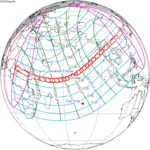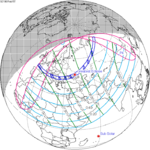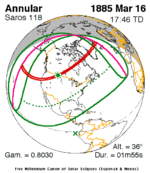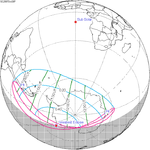
A partial solar eclipse occurred at the Moon's ascending node of orbit on Saturday, October 12, 1996, with a magnitude of 0.7575. A solar eclipse occurs when the Moon passes between Earth and the Sun, thereby totally or partly obscuring the image of the Sun for a viewer on Earth. A partial solar eclipse occurs in the polar regions of the Earth when the center of the Moon's shadow misses the Earth.

An annular solar eclipse occurred at the Moon's ascending node of orbit on Friday, January 26, 1990, with a magnitude of 0.967. A solar eclipse occurs when the Moon passes between Earth and the Sun, thereby totally or partly obscuring the image of the Sun for a viewer on Earth. An annular solar eclipse occurs when the Moon's apparent diameter is smaller than the Sun's, blocking most of the Sun's light and causing the Sun to look like an annulus (ring). An annular eclipse appears as a partial eclipse over a region of the Earth thousands of kilometres wide.

An annular solar eclipse will occur at the Moon's ascending node of orbit on Wednesday, January 26, 2028, with a magnitude of 0.9208. A solar eclipse occurs when the Moon passes between Earth and the Sun, thereby totally or partly obscuring the image of the Sun for a viewer on Earth. An annular solar eclipse occurs when the Moon's apparent diameter is smaller than the Sun's, blocking most of the Sun's light and causing the Sun to look like an annulus (ring). An annular eclipse appears as a partial eclipse over a region of the Earth thousands of kilometres wide.

An annular solar eclipse occurred at the Moon's ascending node of orbit on Monday, December 24, 1973, with a magnitude of 0.9174. A solar eclipse occurs when the Moon passes between Earth and the Sun, thereby totally or partly obscuring the image of the Sun for a viewer on Earth. An annular solar eclipse occurs when the Moon's apparent diameter is smaller than the Sun's, blocking most of the Sun's light and causing the Sun to look like an annulus (ring). An annular eclipse appears as a partial eclipse over a region of the Earth thousands of kilometres wide. Annularity was visible from southern Mexico, southwestern Nicaragua, Costa Rica including the capital city San José, Panama, Colombia including the capital city Bogotá, southern Venezuela, Brazil, southern Guyana, southern Dutch Guiana, southern French Guiana, Portuguese Cape Verde including the capital city Praia, Mauritania including the capital city Nouakchott, Spanish Sahara, Mali, and Algeria.

An annular solar eclipse will occur at the Moon's ascending node of orbit on Monday, February 5, 2046, with a magnitude of 0.9232. A solar eclipse occurs when the Moon passes between Earth and the Sun, thereby totally or partly obscuring the image of the Sun for a viewer on Earth. An annular solar eclipse occurs when the Moon's apparent diameter is smaller than the Sun's, blocking most of the Sun's light and causing the Sun to look like an annulus (ring). An annular eclipse appears as a partial eclipse over a region of the Earth thousands of kilometres wide.

A partial solar eclipse occurred at the Moon's ascending node of orbit on Tuesday, May 9, 1967, with a magnitude of 0.7201. A solar eclipse occurs when the Moon passes between Earth and the Sun, thereby totally or partly obscuring the image of the Sun for a viewer on Earth. A partial solar eclipse occurs in the polar regions of the Earth when the center of the Moon's shadow misses the Earth.

An annular solar eclipse occurred at the Moon's ascending node of orbit on Friday, August 11, 1961, with a magnitude of 0.9375. A solar eclipse occurs when the Moon passes between Earth and the Sun, thereby totally or partly obscuring the image of the Sun for a viewer on Earth. An annular solar eclipse occurs when the Moon's apparent diameter is smaller than the Sun's, blocking most of the Sun's light and causing the Sun to look like an annulus (ring). An annular eclipse appears as a partial eclipse over a region of the Earth thousands of kilometres wide. A small annular eclipse covered only 94% of the Sun in a very broad path, 499 km wide at maximum, and lasted 6 minutes and 35 seconds.

An annular solar eclipse will occur at the Moon's ascending node of orbit on Sunday, September 22, 2052, with a magnitude of 0.9734. A solar eclipse occurs when the Moon passes between Earth and the Sun, thereby totally or partly obscuring the image of the Sun for a viewer on Earth. An annular solar eclipse occurs when the Moon's apparent diameter is smaller than the Sun's, blocking most of the Sun's light and causing the Sun to look like an annulus (ring). An annular eclipse appears as a partial eclipse over a region of the Earth thousands of kilometres wide.

An annular solar eclipse will occur at the Moon's ascending node of orbit on Sunday, July 1, 2057, with a magnitude of 0.9464. A solar eclipse occurs when the Moon passes between Earth and the Sun, thereby totally or partly obscuring the image of the Sun for a viewer on Earth. An annular solar eclipse occurs when the Moon's apparent diameter is smaller than the Sun's, blocking most of the Sun's light and causing the Sun to look like an annulus (ring). An annular eclipse appears as a partial eclipse over a region of the Earth thousands of kilometres wide.

An annular solar eclipse will occur at the Moon's ascending node of orbit on Sunday, February 17, 2064, with a magnitude of 0.9262. A solar eclipse occurs when the Moon passes between Earth and the Sun, thereby totally or partly obscuring the image of the Sun for a viewer on Earth. An annular solar eclipse occurs when the Moon's apparent diameter is smaller than the Sun's, blocking most of the Sun's light and causing the Sun to look like an annulus (ring). An annular eclipse appears as a partial eclipse over a region of the Earth thousands of kilometres wide.

An annular solar eclipse will occur at the Moon's ascending node of orbit on Sunday, December 16, 2085, with a magnitude of 0.9971. A solar eclipse occurs when the Moon passes between Earth and the Sun, thereby totally or partly obscuring the image of the Sun for a viewer on Earth. An annular solar eclipse occurs when the Moon's apparent diameter is smaller than the Sun's, blocking most of the Sun's light and causing the Sun to look like an annulus (ring). An annular eclipse appears as a partial eclipse over a region of the Earth thousands of kilometres wide. If a moon with same apparent diameter in this eclipse near the Aphelion, it will be Total Solar Eclipse, but in this time of the year, just 2 weeks and 4 days before perihelion, it is an Annular Solar Eclipse.

An annular solar eclipse will occur at the Moon's ascending node of orbit on Saturday, July 13, 2075, with a magnitude of 0.9467. A solar eclipse occurs when the Moon passes between Earth and the Sun, thereby totally or partly obscuring the image of the Sun for a viewer on Earth. An annular solar eclipse occurs when the Moon's apparent diameter is smaller than the Sun's, blocking most of the Sun's light and causing the Sun to look like an annulus (ring). An annular eclipse appears as a partial eclipse over a region of the Earth thousands of kilometers wide.

An annular solar eclipse will occur at the Moon's ascending node of orbit on Friday, February 27, 2082, with a magnitude of 0.9298. A solar eclipse occurs when the Moon passes between Earth and the Sun, thereby totally or partly obscuring the image of the Sun for a viewer on Earth. An annular solar eclipse occurs when the Moon's apparent diameter is smaller than the Sun's, blocking most of the Sun's light and causing the Sun to look like an annulus (ring). An annular eclipse appears as a partial eclipse over a region of the Earth thousands of kilometres wide.

An annular solar eclipse will occur at the Moon's ascending node of orbit on Saturday, March 21, 2099, with a magnitude of 0.93. A solar eclipse occurs when the Moon passes between Earth and the Sun, thereby totally or partly obscuring the image of the Sun for a viewer on Earth. An annular solar eclipse occurs when the Moon's apparent diameter is smaller than the Sun's, blocking most of the Sun's light and causing the Sun to look like an annulus (ring). An annular eclipse appears as a partial eclipse over a region of the Earth thousands of kilometres wide.

An annular solar eclipse will occur at the Moon's ascending node of orbit between Wednesday, March 10 and Thursday, March 11, 2100, with a magnitude of 0.9338. A solar eclipse occurs when the Moon passes between Earth and the Sun, thereby totally or partly obscuring the image of the Sun for a viewer on Earth. An annular solar eclipse occurs when the Moon's apparent diameter is smaller than the Sun's, blocking most of the Sun's light and causing the Sun to look like an annulus (ring). An annular eclipse appears as a partial eclipse over a region of the Earth thousands of kilometers wide. The path of annularity will move from Indonesia at sunrise, over the islands of Hawaii and Maui around noon, and through the northwestern United States at sunset.

An annular solar eclipse will occur at the Moon's ascending node of orbit on Thursday, July 23, 2093, with a magnitude of 0.9463. A solar eclipse occurs when the Moon passes between Earth and the Sun, thereby totally or partly obscuring the image of the Sun for a viewer on Earth. An annular solar eclipse occurs when the Moon's apparent diameter is smaller than the Sun's, blocking most of the Sun's light and causing the Sun to look like an annulus (ring). An annular eclipse appears as a partial eclipse over a region of the Earth thousands of kilometres wide.

An annular solar eclipse will occur at the Moon's ascending node of orbit on Thursday, October 14, 2088, with a magnitude of 0.9727. A solar eclipse occurs when the Moon passes between Earth and the Sun, thereby totally or partly obscuring the image of the Sun for a viewer on Earth. An annular solar eclipse occurs when the Moon's apparent diameter is smaller than the Sun's, blocking most of the Sun's light and causing the Sun to look like an annulus (ring). An annular eclipse appears as a partial eclipse over a region of the Earth thousands of kilometres wide.

An annular solar eclipse occurred at the Moon's ascending node of orbit on Thursday, July 20, 1944, with a magnitude of 0.97. A solar eclipse occurs when the Moon passes between Earth and the Sun, thereby totally or partly obscuring the image of the Sun for a viewer on Earth. An annular solar eclipse occurs when the Moon's apparent diameter is smaller than the Sun's, blocking most of the Sun's light and causing the Sun to look like an annulus (ring). An annular eclipse appears as a partial eclipse over a region of the Earth thousands of kilometres wide. Annularity was visible from British Uganda, Anglo-Egyptian Sudan, British Kenya, Ethiopia, British Somaliland, British Raj, Burma, Thailand, French Indochina, Philippines, South Seas Mandate in Japan the Territory of New Guinea.

An annular solar eclipse occurred at the Moon's ascending node of orbit on Friday, February 24, 1933, with a magnitude of 0.9841. A solar eclipse occurs when the Moon passes between Earth and the Sun, thereby totally or partly obscuring the image of the Sun for a viewer on Earth. An annular solar eclipse occurs when the Moon's apparent diameter is smaller than the Sun's, blocking most of the Sun's light and causing the Sun to look like an annulus (ring). An annular eclipse appears as a partial eclipse over a region of the Earth thousands of kilometres wide. Annularity was visible from Chile, Argentina, Portuguese Angola, French Equatorial Africa, Belgian Congo, Anglo-Egyptian Sudan, Ethiopia, French Somaliland, southeastern Italian Eritrea, and Mutawakkilite Kingdom of Yemen, Aden Protectorate and Aden Province in British Raj.

An annular solar eclipse occurred at the Moon's ascending node of orbit on Monday, March 7, 1932, with a magnitude of 0.9277. A solar eclipse occurs when the Moon passes between Earth and the Sun, thereby totally or partly obscuring the image of the Sun for a viewer on Earth. An annular solar eclipse occurs when the Moon's apparent diameter is smaller than the Sun's, blocking most of the Sun's light and causing the Sun to look like an annulus (ring). An annular eclipse appears as a partial eclipse over a region of the Earth thousands of kilometres wide.


















































































































